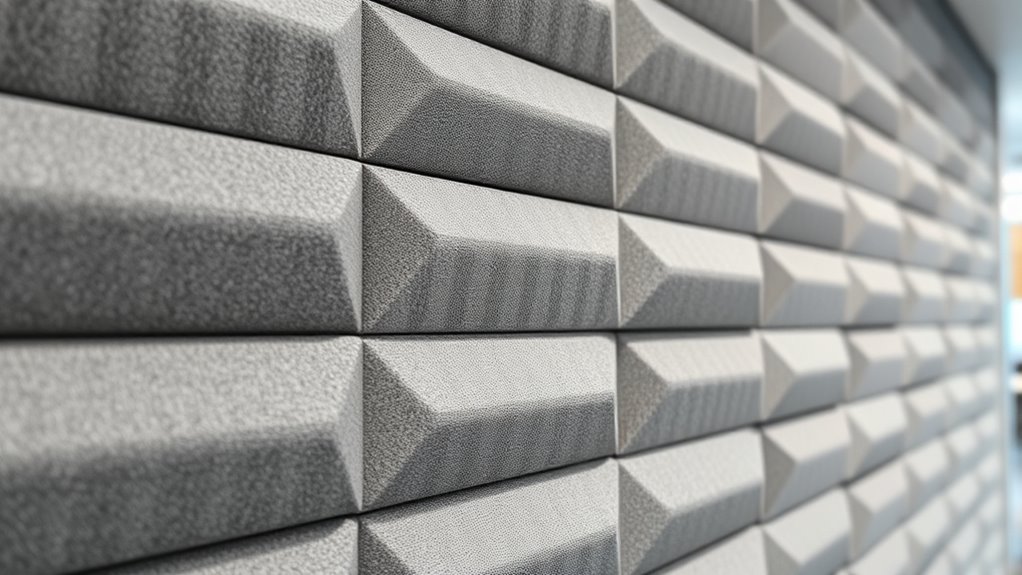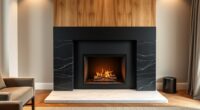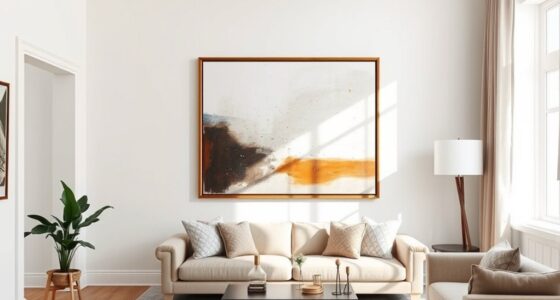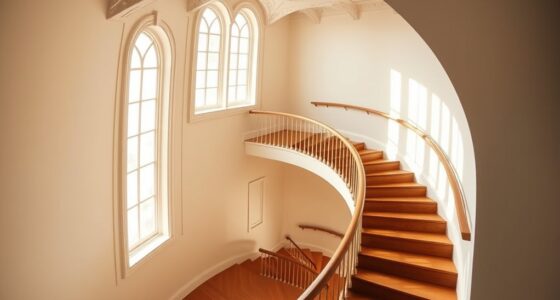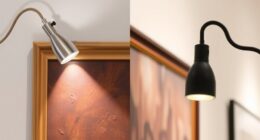Sound-absorbing wall panels work by disrupting sound waves and reducing echoes in a space. They use materials with high porosity and density, like mineral wool or fiberglass, to soak up sound energy—especially mid to high frequencies. Surface textures and shapes help diffuse or absorb sound more effectively. Proper placement at key reflection points guarantees maximum performance. Keep exploring to discover how these features come together for a quieter, more comfortable environment.
Key Takeaways
- Sound-absorbing wall panels reduce reflections and echoes by trapping sound energy within porous or dense materials.
- They disrupt sound wave interference and bouncing, creating a quieter, clearer environment.
- Material properties like porosity and density determine how effectively panels absorb mid to high frequencies.
- Surface texture and shape modifications enhance diffusion and prevent resonance, improving overall acoustic performance.
- Proper placement at key reflection points maximizes their sound absorption and noise reduction benefits.
The Basics of Sound Absorption

Sound absorption refers to the process of reducing sound reflections and echoes within a space. When sound waves hit surfaces, they bounce and create echoes that can clutter your environment. Sound wave interference plays a key role here; absorbing panels disrupt these waves, preventing them from bouncing back. This interference diminishes the overall sound energy, making the space quieter and more comfortable. Effective sound absorption is essential for ambient noise control, helping to reduce background noise and improve sound clarity. By minimizing reflections, you’ll notice a more balanced acoustic environment, whether in an office, home theater, or classroom. Understanding these basics shows how sound-absorbing wall panels enhance comfort by controlling how sound moves and interacts within the room. Incorporating Sound wave interference management techniques further optimizes acoustic performance. Properly designed panels can also contribute to noise reduction by targeting specific frequencies and sound sources.
Materials Used in Sound-Absorbing Panels
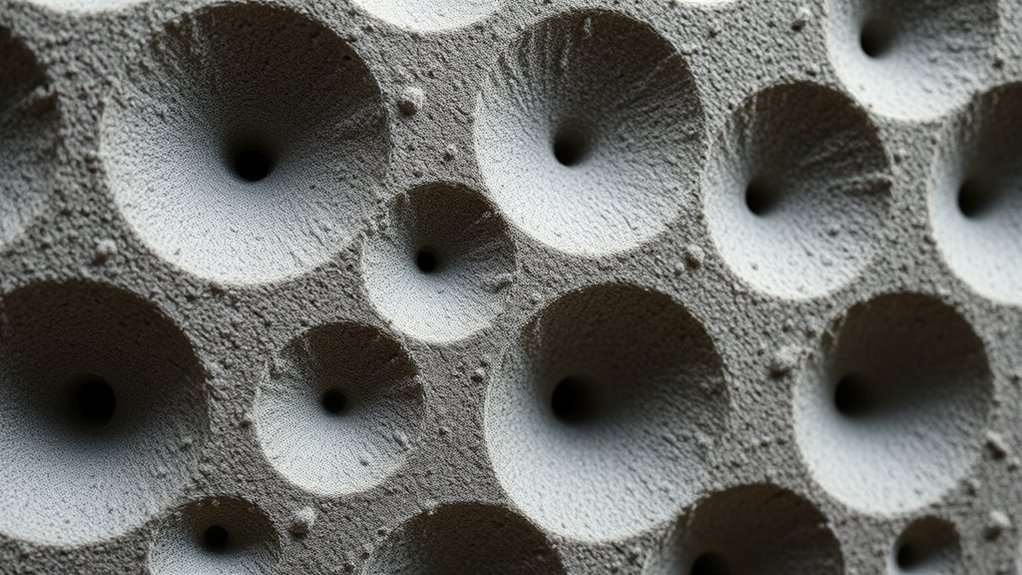
To effectively reduce echoes and control noise, the materials used in sound-absorbing panels play a vital role. You’ll find options that balance performance, eco-friendliness, and cost. Eco-friendly materials like recycled cotton, cork, and cellulose offer sustainable choices without sacrificing sound absorption. For those on a budget, cost-effective options such as mineral wool, foam, and fiberglass provide high efficiency at lower prices. Additionally, selecting the appropriate sound-absorbing materials can optimize acoustic performance for your space. Understanding the causes of narcissism can help in choosing materials that promote healthier environments, especially in spaces prone to interpersonal conflicts. Incorporating acoustic performance factors into your selection process ensures better sound quality and noise control.
How Sound Waves Interact With Panel Surfaces
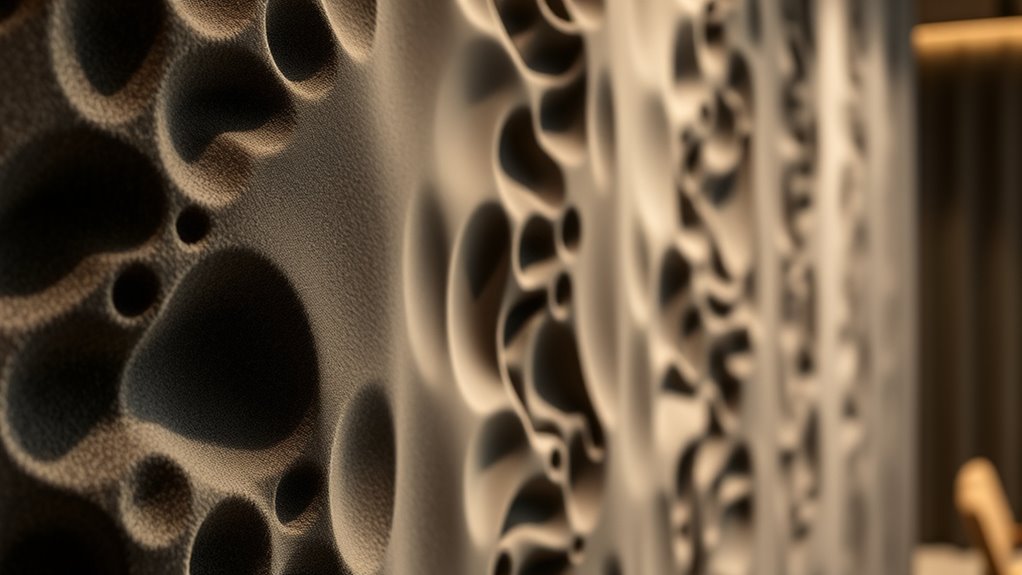
When sound waves encounter a panel surface, their behavior depends on the material’s properties and surface texture. Resonance effects can amplify certain sound wave frequencies, causing specific sounds to be reflected or absorbed more effectively. The surface texture influences how sound waves are scattered or absorbed; rougher surfaces tend to diffuse sound, reducing direct reflections. Smooth surfaces may cause resonance effects, where particular frequencies bounce back and create echoes or standing waves. These interactions determine whether sound energy is absorbed, reflected, or transmitted through the panel. Understanding how sound waves interact with various surface textures and resonance effects helps you select the right panels to optimize acoustics and minimize unwanted noise. Additionally, advancements in AI-driven acoustic analysis can assist in designing more effective soundproofing solutions tailored to your environment’s needs. Recognizing material properties such as porosity and density can further enhance your ability to choose panels that effectively control sound behavior. Employing surface texture considerations can optimize sound diffusion and absorption, leading to better acoustic environments. Incorporating knowledge of acoustic resonance can help prevent undesirable echo and standing wave issues, ensuring a clearer soundscape. This knowledge ensures effective sound control tailored to your environment’s needs.
The Role of Porosity and Density
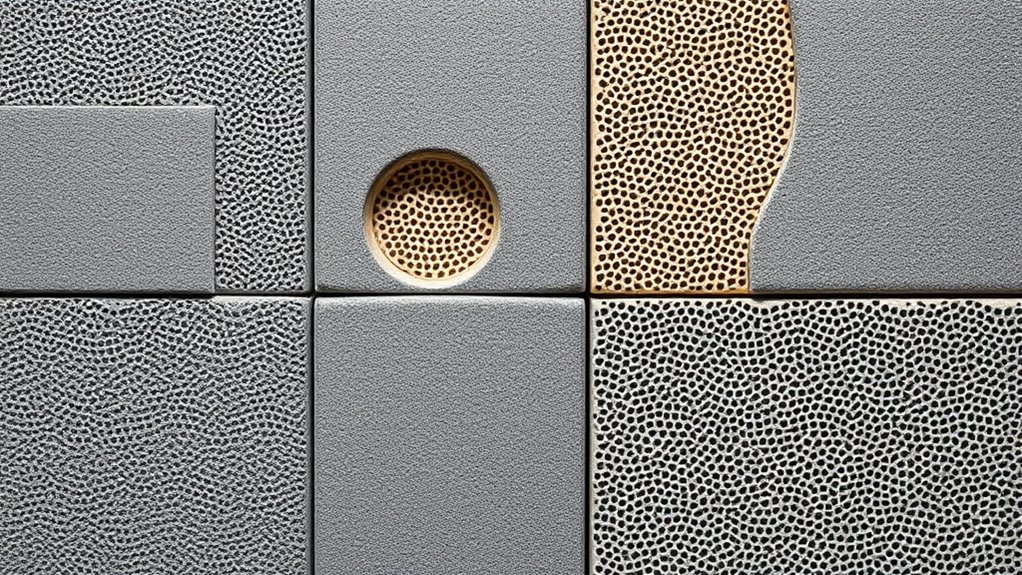
Have you ever wondered how porosity and density influence a wall panel’s ability to absorb sound? These factors are essential because they determine how effectively sound waves enter and dissipate within the material. Porosity control allows you to fine-tune the size and distribution of air pockets, optimizing sound absorption. Higher porosity typically means more sound energy gets trapped, reducing echo and noise. Density variation also plays a role; denser materials can absorb mid to high frequencies better but may reflect lower frequencies. Striking the right balance between porosity and density ensures your wall panels perform at their best. Understanding these properties helps you choose or design panels that maximize sound absorption, creating quieter, more comfortable spaces. Regularly assessing material properties can further enhance soundproofing effectiveness, especially when considering different material characteristics to suit specific acoustic needs. Incorporating bees’ natural materials like propolis or honeycomb structures can influence the porosity and density of certain sound-absorbing panels, potentially improving their acoustic performance.
Design Features That Enhance Sound Absorption
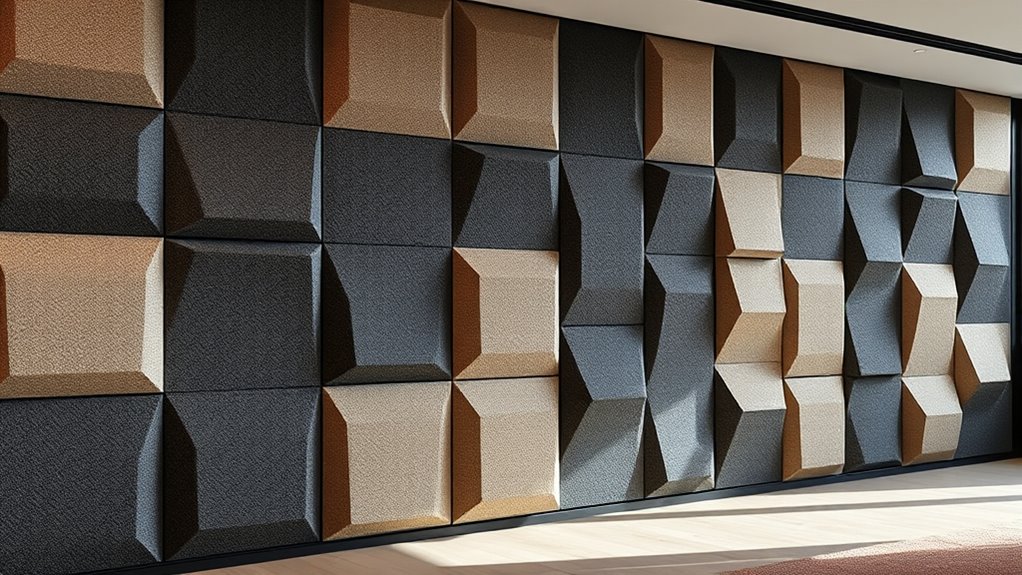
Your choice of materials and their density can markedly improve sound absorption, so consider options that are specifically designed for acoustic performance. The surface texture and shape of the panels also matter—rougher or irregular surfaces tend to trap sound better. Incorporating high fiber content into your panels can further enhance their ability to absorb sound waves effectively. By combining these design features, you can optimize your wall panels for maximum sound absorption.
Material Composition and Density
What makes certain wall panels more effective at absorbing sound? It primarily comes down to their material composition and density variation. Sound-absorbing panels are crafted from porous materials like mineral wool, fiberglass, or foam, which trap sound waves within their structure. The specific material determines how well it dampens noise. Additionally, density variation within the panel enhances performance—denser areas can block sound transmission, while less dense regions absorb sound energy more efficiently. By selecting materials with the right composition and tuning their density, you optimize the panel’s ability to reduce echoes and reverberation. This careful engineering ensures better sound absorption, making your space quieter and more comfortable.
Surface Texture and Shape
Ever wondered how the surface design of wall panels influences their sound absorption? Texture variation plays an essential role by disrupting sound waves, reducing echoes, and improving acoustic performance. Panels with rougher or uneven surfaces create more friction, helping to absorb sound energy more effectively. Incorporating sound-absorbing materials can further enhance the panels’ effectiveness. Shape modification also enhances sound absorption; for example, panels with curved, angled, or irregular shapes break up sound waves and prevent reflection. These design features increase the surface area exposed to sound waves and promote better diffusion. Additionally, selecting appropriate materials can further improve the effectiveness of sound-absorbing panels. Understanding regional differences in acoustic needs allows for tailored design choices that maximize sound control. Incorporating surface textures and shapes into your design not only improves acoustics but also adds visual interest, making your space both functional and appealing.
Installation and Placement Strategies
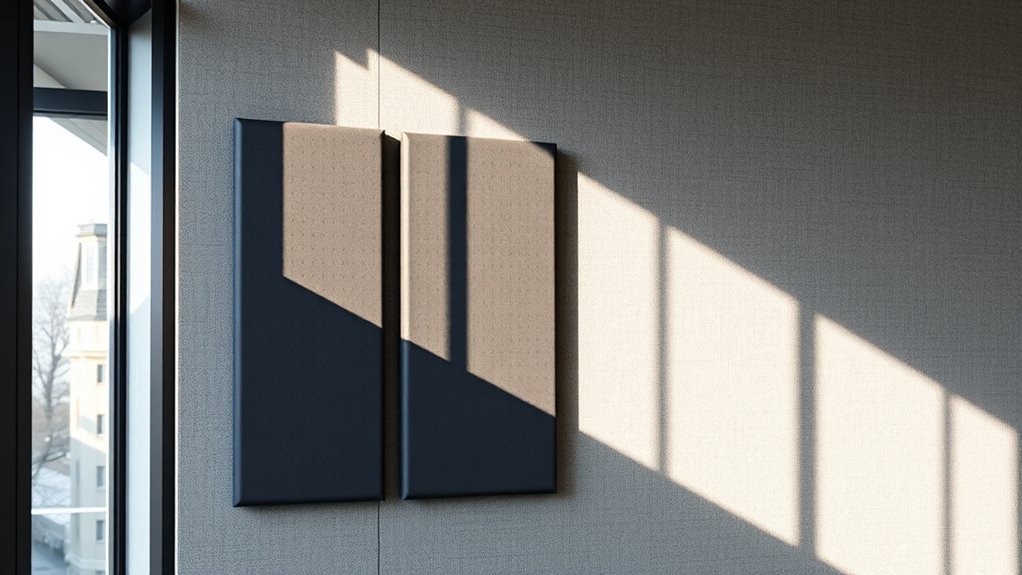
Are you unsure where to place sound-absorbing wall panels for maximum effectiveness? Start by considering mounting techniques that guarantee secure attachment without damaging your walls. Using brackets, adhesive, or hanging systems allows flexibility in placement. For optimal sound absorption, position panels at key reflection points, such as directly across from noise sources or along walls facing open spaces. Keep maintenance tips in mind—regularly dust panels and check mounts for stability to maintain their performance. Avoid placing panels too high or low; instead, aim for ear level or slightly above, where sound waves are most active. Additionally, understanding sound wave behavior can help determine the best placement to improve acoustics. Proper placement not only enhances acoustics but also ensures your panels stay secure and effective over time, especially when considering installation techniques that maximize stability and longevity. Recognizing how sound absorption principles influence panel placement can further optimize your acoustic treatment. Being aware of room acoustics can also guide you in achieving a balanced sound environment.
Comparing Different Types of Acoustic Panels
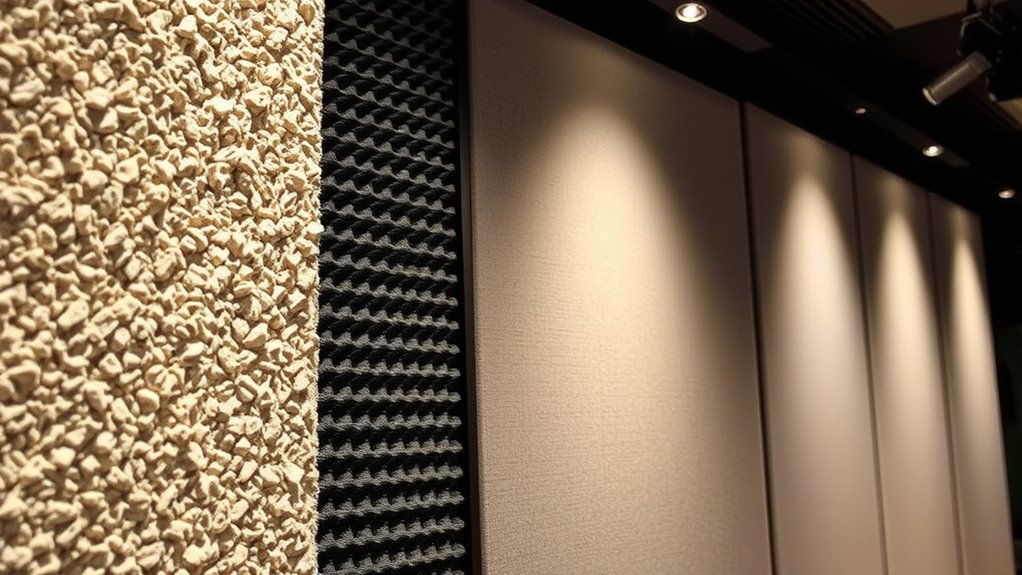
When comparing acoustic panels, you’ll notice differences in material types and how effectively they absorb sound. Aesthetics also matter, as options range from sleek designs to colorful patterns that match your space. Understanding these factors helps you choose panels that meet both your soundproofing and style needs. Additionally, selecting panels with specific sound absorption properties can optimize acoustic performance in various environments. Proper installation and placement also play a crucial role in maximizing their effectiveness, as highlighted in SQA Best Practices. Recognizing the significance of famous quotes about fatherhood can serve as inspiration for creating welcoming spaces that foster connection and comfort.
Material Types and Effectiveness
Choosing the right type of acoustic panel depends on understanding how different materials perform in sound absorption. Fiber reinforcement is a common feature that enhances a panel’s ability to dampen sound waves effectively. For example, mineral wool and fiberglass panels excel in absorbing mid to high frequencies due to their porous, dense structures. Eco-friendly materials, such as recycled cotton or plant-based fibers, are gaining popularity because they combine sustainability with good acoustic performance. These materials often have excellent fiber reinforcement, which traps sound energy and reduces echo. While some panels prioritize durability and aesthetic appeal, others focus on environmental impact. By comparing material types—considering fiber reinforcement and eco-friendly options—you can select panels that suit your soundproofing needs and align with your values.
Aesthetic and Design Options
Different acoustic panels come in a variety of designs that can complement your space’s aesthetic while effectively managing sound. You can choose from numerous options to match your decor and personal style. For example, some panels feature vibrant color options to add a pop of color, while others have sleek, neutral tones for a minimalist look. Decorative patterns, such as geometric shapes or textured surfaces, can serve as focal points or subtle accents. You might opt for fabric-covered panels with custom prints or wood finishes that blend seamlessly into natural interiors. Whether you want a bold statement or a discreet solution, there’s a design to suit your needs. Explore these options to enhance both the sound quality and the visual appeal of your space.
Benefits Beyond Noise Reduction
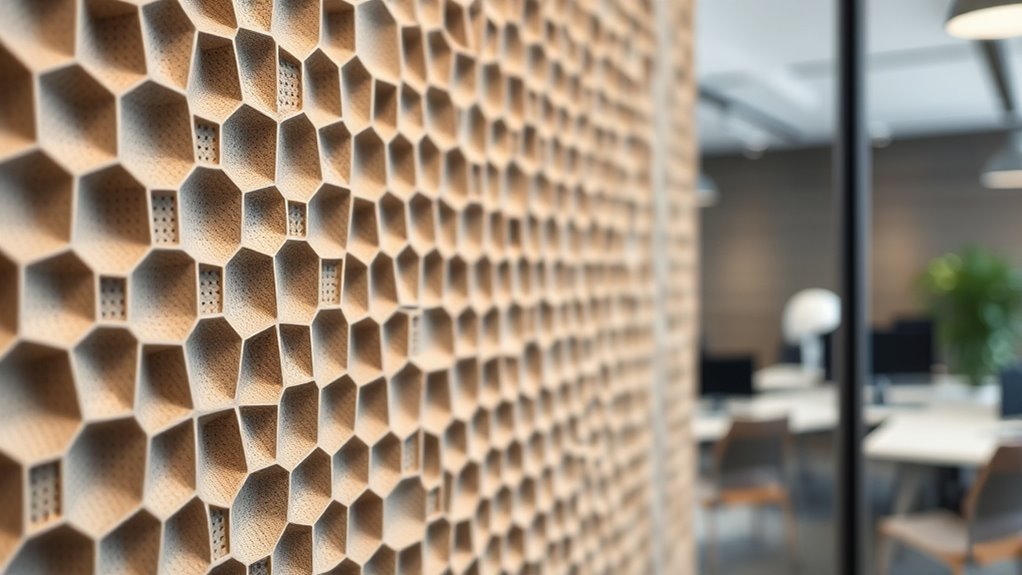
Sound-absorbing wall panels offer benefits that extend well beyond simply reducing noise levels. They can enhance interior aesthetics by adding texture, color, and style to your space, making it more inviting and visually appealing. These panels help improve spatial acoustics by controlling sound reflections, creating a more balanced and comfortable environment. This not only makes conversations clearer but also reduces echo, especially in large or open areas. As a result, your space feels more intimate and less chaotic. Additionally, many panels come in customizable designs, allowing you to match them with your decor. Overall, these panels serve a dual purpose: boosting visual appeal and elevating acoustic comfort, making your environment more functional and enjoyable without sacrificing style.
Factors Influencing Panel Effectiveness
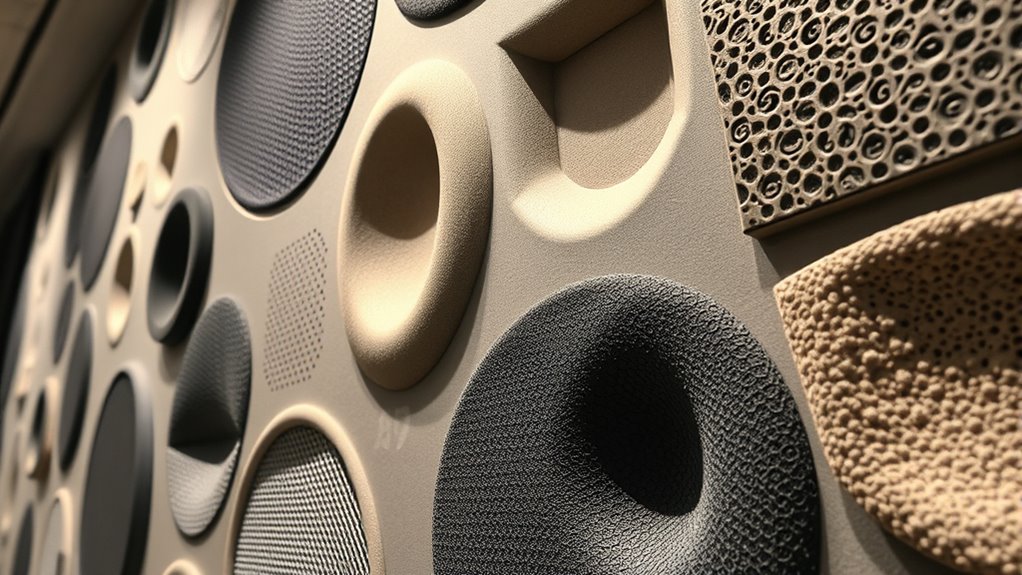
The effectiveness of wall panels depends on several key factors that influence how well they absorb sound and enhance acoustic comfort. Panel durability is essential; if panels deteriorate quickly, their sound absorption declines, reducing overall effectiveness. Additionally, cost considerations impact your choice—more durable, high-quality panels often come at a higher price but last longer. The panel material also matters: porous, soft materials typically absorb sound better than hard surfaces. Installation quality is critical; improper mounting can create gaps, diminishing soundproofing. Finally, the design and thickness of the panels play a role, as thicker panels generally provide better sound absorption. Balancing these factors ensures you select panels that are both effective and suited to your budget and environment.
Frequently Asked Questions
Can Sound-Absorbing Panels Improve Speech Clarity in Large Spaces?
Yes, sound-absorbing panels can substantially improve speech clarity in large spaces. They enhance speech intelligibility by reducing background noise and echo, making conversations easier to understand. When you install these panels, you’ll notice less noise reverberation and clearer communication, especially in busy or expansive areas. This creates a more comfortable environment for dialogue, meetings, or presentations, ensuring everyone can hear and understand without straining.
Do Different Panel Shapes Influence Sound Absorption Efficiency?
You might notice that panel shape markedly influences absorption efficiency, much like how different melodies evoke varied emotions. While curved panels often trap sound waves more effectively, irregular shapes can scatter noise, reducing echo. Choosing the right panel shape enhances sound absorption, making your space clearer and more comfortable. So, don’t underestimate the power of shape—it’s a key factor in optimizing acoustic performance and creating the ideal environment.
Are There Eco-Friendly Materials Suitable for Acoustic Panels?
Yes, eco-friendly materials like recyclable and biodegradable options are suitable for acoustic panels. You can choose panels made from recycled cotton, cork, or bamboo, which effectively absorb sound while reducing environmental impact. These materials are sustainable, biodegradable, and help lower your carbon footprint. By selecting eco-conscious options, you guarantee your space stays quiet and environmentally responsible at the same time.
How Do Climate Conditions Affect the Durability of Sound-Absorbing Panels?
Climate conditions directly impact the durability of your sound-absorbing panels. If they lack moisture resistance, high humidity can cause mold or warping, reducing effectiveness. Temperature fluctuations can lead to material degradation or cracking if the panels aren’t designed for temperature stability. To guarantee longevity, choose panels with good moisture resistance and temperature stability, especially if your environment experiences extreme or changing conditions. Proper installation and maintenance also help preserve their performance.
Can Panels Be Customized to Match Interior Design Aesthetics?
Did you know that 78% of interior designers prioritize aesthetic integration? You can definitely customize sound-absorbing wall panels to match your interior design. With a variety of custom design options, you can choose colors, textures, and patterns that blend seamlessly with your space. This way, you enhance your room’s acoustics without sacrificing style, creating a harmonious environment that reflects your unique aesthetic.
Conclusion
By understanding how sound-absorbing wall panels work, you can turn your space into a peaceful oasis amid the noise. Think of these panels as your personal noise-canceling shield, soaking up unwanted sound waves before they reach your ears. With the right materials, design, and placement, you’ll create a calm environment that feels like a quiet harbor in a storm. Embrace the power of acoustic panels, and let silence become your new soundtrack.
